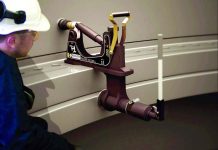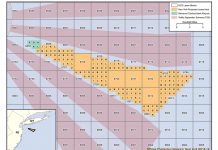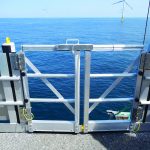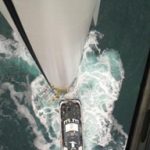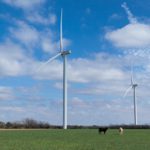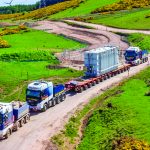Challenges in providing adequate erosion control in the field require a diverse toolbox of solutions. As lands are disturbed, erosion and sediment control professionals are demanding best management practices that can be specified, installed, and inspected with confidence. Wind energy professionals, especially those on the operations and maintenance side of the wind energy industry, should take the time now to set up the proper procedures to prevent problems later.
Protect the Site First
Water always behaves the same way; it seeks its own level. What does change is the topography and elevation in the settling points.  As soil is deposited, it diminishes the volume of a drainage route or a retention basin. Therefore, drainage routes and basins must be cleared of obstructions, dirt, and debris that may have accumulated. Flow channels, swales, riprap beds, and culverts need to be cleaned out to allow unrestricted water passage. In addition to removing debris, trash, and silt build-up, contractors in operations and maintenance should make any repairs necessary to drain grates, catch basins, inlets, channels, and roadways to ensure that storm water flows freely. Pay close attention to culverts under roadways using adequate lighting to inspect and ensure unobstructed water passage can occur. Maintain a channel cleaning and maintenance program that addresses vegetation trimming, debris, sediment, and trash in those flood channels.
As soil is deposited, it diminishes the volume of a drainage route or a retention basin. Therefore, drainage routes and basins must be cleared of obstructions, dirt, and debris that may have accumulated. Flow channels, swales, riprap beds, and culverts need to be cleaned out to allow unrestricted water passage. In addition to removing debris, trash, and silt build-up, contractors in operations and maintenance should make any repairs necessary to drain grates, catch basins, inlets, channels, and roadways to ensure that storm water flows freely. Pay close attention to culverts under roadways using adequate lighting to inspect and ensure unobstructed water passage can occur. Maintain a channel cleaning and maintenance program that addresses vegetation trimming, debris, sediment, and trash in those flood channels.
On a smaller scale, blockage in culverts can lead to similar damage, causing water to flow over roadways and erode or destroy site access infrastructure. To help prevent this, swales or drainages leading into basins must be intact and capable of carrying storm water at a controlled rate. A breach in a drainage route or flow path negates the design capabilities to move water across the property or into an appropriate catch basin. A good rule of thumb is to inspect what you expect by looking at the “story marks” on the property from the last wet weather event.
Hydroseeding
Effective erosion control measures will go a long way when it comes to preventing or controlling erosion on wind energy projects. Hydroseeding is a quick, cost-efficient way to apply seeds, mulch, and fertilizer to recently disturbed soils found on any construction project. The value of hydroseed can be seen in both erosion control and dust mitigation. It’s also an effective revegetation strategy. Selecting the right contractor is always important, as is ensuring they have trained applicators who have sprayed on wind energy projects. Seed mix, mulch rate, fertilizer, application uniformity, overspray mitigation, and other factors need to be well-thought-out. Selecting the right seed mix for your projects’ climate and soil content and working with an unbiased consultant to help determine the appropriate seed is also important. The seed mix can change your price per acre by hundreds of dollars. With projects ranging from 20 acres to 2,000 acres, this can result in significant savings.
Here are a few more key points to consider when using hydroseeding:
• It’s a great option for disturbed soil.
• Hydroseeding is normally done after a project is built in accordance with a revegetation plan.
• Selecting a vendor with experience spraying in the wind energy array is critical. This is certainly an instance where choosing the best quality is more important than price alone.
• Selecting the right seed mix is also critical. It will impact the overall cost and success.
• You will need unbiased insight into the right seed. Some seed suppliers will recommend a seed that only they carry, which may or may not be the best value or most effective option.
• Hydroseeding should be applied prior to the expected rainfall. Generally, this is from October through March.
Weed control is a big land management issue, especially after El Niño drenched most of the nation this year. Weeds are expected to be at an all-time high as fire season kicks in. It would be a good idea to budget your wind site more than usual for this year’s operations and maintenance needs. When it comes to mowing, we recommend a minimum of two times for most sites starting around May and going through October. World Wind & Solar provides services for a variety of wind projects that range from 200 to 3,000 acres, and the company utilizes a variety of custom-made equipment and chemical strategies in order to combat weeds.
One of the biggest weed challenges that wind industry members face is contending with tumbleweeds, also known as thistle. In the Antelope Valley alone last year, World Wind & Solar removed more than 2,000 tons of tumbleweeds, mostly from both solar and wind projects. Tumbleweeds can cause serious problems when they get caught up in racking systems, cable trays, pylons, and inverters. In order to prevent these problems, it’s better to be proactive than reactive. Each weed can produce up to 200,000 seeds if not removed from the site, and weeds contain oils that can be extremely flammable. They should be mowed while they’re still green and physically removed from the site. A chemical weed abatement program that requires careful planning and permitting can also be used.
 Now Is the Time for Fire Prevention
Now Is the Time for Fire Prevention
Wind owners and operators may expect more visits from the fire departments this year due to El Niño, so make sure you’re in compliance.
Most fire requirements demand a defensible space of 500 feet for the site, but codes vary by region. It is also important to know that inspections are conducted throughout the dry season and that the property must be maintained in order to remain in compliance. Even if a property owner abates their property early in the season, there is potential for re-growth.
Clearing around power poles, transformer pads, and junction boxes is essential, along with the other obvious places on your sites such as roads and buildings. A 10-foot radius around power poles will help prevent a fire from starting if there is any arching due to a failed component. Trees and other large brush should be cleared at least 8 feet below a power line. Clearing a radius of 10 feet around transformers and junction boxes will help prevent a fire from starting if the component has a major failure that causes sparks.
Maintaining your roads will also help as a fire break if a large brush fire breaks out. Most roads in high-risk fire areas are left at 20 feet wide after a project has been constructed, allowing for access and to serve as a fire break.
Mowing weeds can be a fire risk, so it is imperative that it be done safely. One small spark from a mower blade hitting a rock can result in a big fire. Given the high-dollar assets that are at stake on wind farms, it would be wise to hire licensed professionals with proven track records, especially given the chemical and mechanical weed abatement strategies used.
More Tips
In addition to site-preparation steps such as hydroseeding and weed abatement, here are some additional preparation steps to include in your plan:
• Roadways that provide critical site access should be constructed above grade and of a road-base type material. To maintain or prepare non-paved roads for wet conditions, soil stabilizers can be added periodically to bind the base material, preventing wet weather deterioration, which also helps to minimize dust in the dryer months.
• Fencing can restrict water flow as floating debris builds up, creating a beaver dam effect. Look for areas where water flow passes under fencing and remove any accumulated debris.
• Develop a checklist to inspect all electrical equipment enclosures to ensure cabinets and doors are closed and secured with a proper weather seal.
• Inspect conduit openings to ensure they are weather-tight. In some applications, high-quality expanding foam or UV-resistant RTV can aid in filling gaps or addressing areas of concern.
Lastly, facilities must review the regulatory requirements as dictated by their site-specific storm water pollution prevention plan (SWPPP) to gain a detailed understanding of expectations for water retention and pass-through by sampling frequencies and testing and recording retention. With this knowledge, the next step is to create a standard operating procedure (SOP) for wet weather events and develop personnel training so that adherence to the SOP becomes a procedure that is driven companywide. Implementing this allows contractors in operations and maintenance time to set up vendor support agreements to assist if the water intrusion is more evasive than the site and staff can effectively manage.
Conclusion
Given all of the potential devastating effects from erosion, wind professionals should take every necessary step to minimize damage and protect their projects. The past decade of droughts and catastrophic wildfires have left parched landscapes that are ill-prepared, so site assessments and maintenance practices are particularly critical. Many wind energy projects are built in mountain passes where mudslides are a looming danger, while others are built on or around dry lakebeds where land is inherently flat and soil peculation is minimal. Either way, this typically means that even a minimal amount of rain can create maximum problems, and the preventative measures discussed in this article can save time and money.
For more information, go to www.worldwindsolar.com.
















